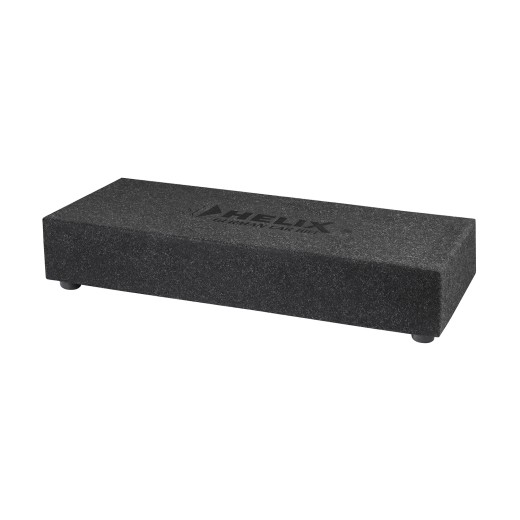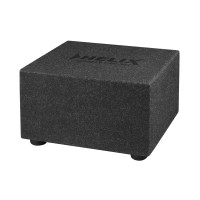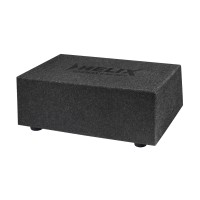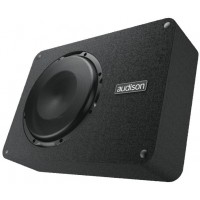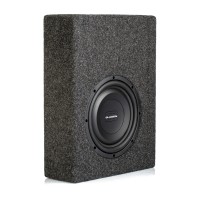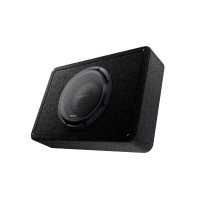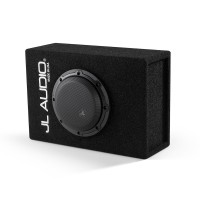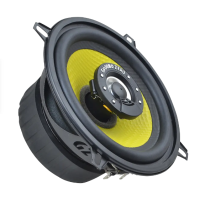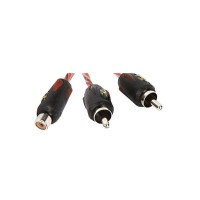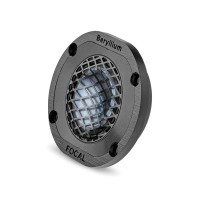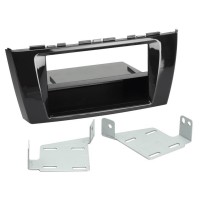Subwoofer Helix K 10SE.2
More about the product
- Use our consulting room
- You can return the goods to us within 14 days
- Try the product at our store
Subwoofer Helix K 10SE.2
Despite its extremely shallow and compact design, this subwoofer delivers a natural bass performance that can easily compete with larger "conventional" subwoofers. Thanks to its special design, this woofer is particularly suitable for hidden and space-saving installation concepts, such as the double floor of a vehicle. Extremely flat enclosures require sophisticated design details to prevent unwanted vibrations. In the case of the K 10SE.2, the magnetic system is bolted to the rear panel of the enclosure as additional reinforcement.
The extra-stiff, twist-resistant sandwich paper diaphragm coupled with the durable dual voice coil not only converts the amp's power easily and without compression effects into plenty of sound pressure, but also sonically scores with subtle punches. The legs of the K 10SE.2 enclosure have a double meaning. On the one hand, they are part of the structure as a downfire subwoofer and create a defined distance to the floor of the mounting surface, which is then cleverly used for reflection. At the same time, thanks to their velcro inserts, they reliably fix the subwoofer on the carpet so that it does not slide, so in many cases additional fixing is not necessary.
The main features of the subwoofer Helix K 10SE.2
- Subwoofer in a compact closed enclosure.
- 250mm high displacement woofer with handmade paper diaphragm and dual voice coil.
- Downfire enclosure technology for perfect speaker protection and ideal bass dispersion in the vehicle.
- Firm carpet surface with embroidered Helix logo.
- Plug-in screw clamp for quick and safe installation or removal.
- Voice coil impedance configurable via connection terminal: 2 + 2 Ohms, 4 Ohms or 1 + 1 Ohms.
- Compact dimensions of the enclosure.
| Catalog number | K 10SE.2 |
| Brand | Helix |
| Links | Official web presentation |
| RMS powerThe RMS power of the subwoofer is constant power. This is also the performance of continuous use of the subwoofer. If you exceed the power for a longer period of time, irreversible damage or subwoofer voice coil burning! You can tell if the subwoofer is overloaded by the vibration of the subwoofer membrane. | 300 W |
| Max. (maximum performancePeak performance , which the subwoofer can play momentarily (approx. 0.5 s), for example when hitting drums in a song. If the maximum power is exceeded, damage can quickly occur or subwoofer voice coil burning! | 600 W |
| The diameter of the subwoofer in the box | 250mm (10") |
| Sensitivity (SPL 1W/1m)Subwoofer sensitivity or efficiency. The sensitivity of the subwoofer is given in decibels (dB) and, in simple terms, means that the higher the value, the lower the demands on the power of the amplifier. This is a de facto rating of how a subwoofer converts watts to sound. Sensitivity ratings are in noise level measured at 1 meter from the subwoofer using 1 W (watt of power) or using 2.83 volts at the source at 1 meter. A higher decibel level means the subwoofer is louder with less power. For every 3 dB increase in sensitivity, the subwoofer requires half the power to reproduce the same volume. For example, if an 88dB subwoofer needs 300 Watts to produce a certain volume, then a subwoofer with a sensitivity of 91dB needs only 150 Watts to reach the same volume. | 88 dB |
| ImpedanceImpedance - measurement of electrical resistance. When buying a subwoofer, it is very important that everyone make sure that the impedance is compatible with the amplifier that you are connecting to it. For subwoofers with a double voice coil, we recommend following the information in the advice center! Example: A 2 Ohm subwoofer cannot be connected to an amplifier that is only stable up to 4 Ohms. A 4 Ohm subwoofer can easily be used with an amplifier that is stable up to 2 Ohms. Connecting a 4 Ohm subwoofer to an amplifier that is stable up to 4 Ohms also without problems. The most common subwoofer impedance is 4 Ohm. Example: A 2 Ohm subwoofer cannot be connected to an amplifier that is only stable up to 4 Ohms! A 4 Ohm subwoofer can easily be used with an amplifier that is stable up to 2 Ohms. The most common impedance of subwoofers is 1 x 4 Ohm. | 2 + 2 Ω |
| Loudspeaker typeThe closed enclosure is characterized by a simple construction. Closed enclosures are usually smaller than bass-reflex enclosures, and a special damping fleece is used for their damping. A closed baffle has the advantage of preventing an acoustic short between the front and back radiation of the subwoofer diaphragm. The disadvantage is that the closed enclosure raises the natural resonance frequency of the used subwoofer and thereby also increases the lower limit frequency. This is because the back side of the diaphragm is forced to compress and dilute the air inside the enclosure when the subwoofer is radiating in a closed enclosure. This adds to the inherent stiffness of the subwoofer's oscillation system the stiffness of the air in the closed enclosure. This causes an increase in the stiffness of the oscillating system and thus an increase in the resonant frequency of the entire system: subwoofer -> loudspeaker. The increase in resonant frequency for a given subwoofer is greater, the smaller the volume of air in the closed enclosure. The relatively small volume of air in the closed enclosure acts on the subwoofer as an acoustic spring when radiating the back side of the membrane into the enclosed enclosure. USE: Mainly for quality bass listening in the entire band with an emphasis on detail and accurate reproduction in the lower band. Pros and cons: + pure reproduction + small closets + easier tuning - low level of efficiency in deep bass - loudness only at the cost of enormous deflection of the diaphragm - a significant acoustic pressure cannot be expected The bass reflex enclosure is designed in the same way as a closed enclosure, but it also has a so-called bass reflex mouthpiece, or "bass reflex". Needle foam is used to dampen bass reflex enclosures. USE: The ideal use is in cases where the listener wants to achieve a high volume and a good sound pressure level. It is the best compromise between sound quality and performance and is also the most commonly used Pros and cons: + good efficiency in deep bass + a small deflection of the membrane is enough for a large volume - reproduction less accurate than with closed enclosures | Closed |
| What is the baffle made of?Subwoofer enclosures are usually made of 18-22 mm MDF board or pressed chipboard. Due to its higher strength, MDF board is a better material than ordinary chipboard. | MDF |
| Dimensions of the boxEnclosure dimensions are given as height, width and depth, which is often longer at the bottom edge than at the top, due to the bevel of the rear wall. | 132 x 725 x 350 mm |
